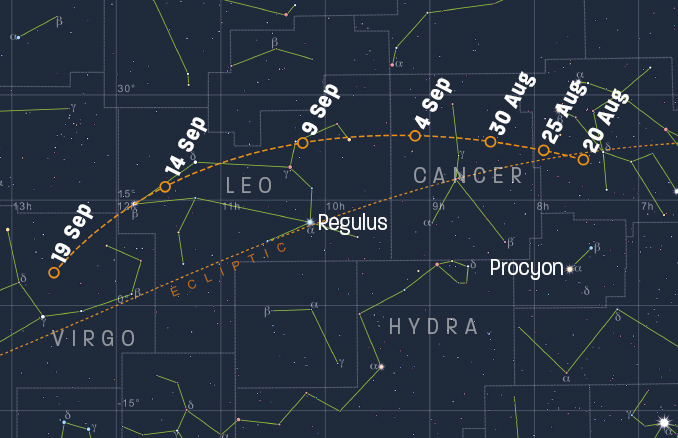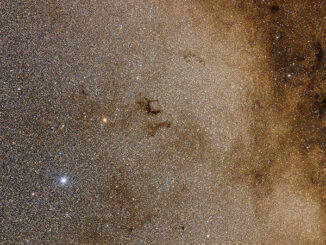
It’s hang on to your observing hats time once more as a brand new comet, C/2023 P1 (Nishimura), discovered on 11 August, promises a dramatic brightening as it hurtles towards the Sun. However, in typical cometary fashion, its behaviour is hard to predict on its first and only visit to the Sun’s harsh environs. There’s a chance it will disintegrate and fizzle out.
Presently Comet C/2023 P1 (Nishimura) lies in the pre-dawn sky tracking north-eastwards among the stars of Gemini. Observing reports are sketchy in the first week or so, but it is shining at around magnitude +9.5 and on discovery was reported with a coma of 5 arcminutes in angular size and a tail eight arcminutes long. Nishimura will be at its closest to Earth, a distance of around 127.1 million kilometres (0.85 AU), on 13 September, and reach perihelion on 18 September, when it lies 32.9 million kilometres (0.22 AU) from the Sun.

When to observe the comet
The comet remains in the pre-dawn sky up to 13 September. A small telescope should easily bag it, provided your observing site has a good horizon to the east-southeast and isn’t too badly afflicted by light pollution. The Moon is well out of the way until early September.
On 20 August at 4.25am, about 90 minutes before sunrise and at the beginning of nautical twilight from London (with the Sun 12° below the horizon), Comet C/2023 P1 (Nishimura) lies around 13° up, some 3° south-east of the magnitude +3.5 star Wasat (delta Geminorum). The comet should be easier to detect on the pre-dawn of 26 August, as it lines up nicely with Gemini’s bright stars Castor and Pollux, the comet located 6.7° below Pollux, the southerly twin. It’s a little better placed now, 4° higher in the sky, with the Minor Planet Center predicting a brightening of one magnitude.
By the end of August, Comet C/2023 P1 (Nishimura) lies in Cancer, maintaining its altitude and located around 4° north-northwest of the Beehive cluster (Messier 44), the brilliant open cluster. If it continues to brighten at the predicted rate the comet will shine at around magnitude +7.5.

Into September: losing altitude but brightening faster
During the first week of September Comet C/2023 P1 (Nishimura) begins to lose altitude as it gets ever closer to the Sun, but compensates by an increased rate of brightening. It should be visible through binoculars at this stage.
The pre-dawn of 7 September finds the comet in Leo, scraping north past magnitude +3 epsilon Leonis as it lies around 13° high in London at 5.05am. A few mornings later Comet C/2023 P1 (Nishimura) dips below 10° altitude as it starts to plunge southwards, now moving across the sky over four times faster than at discovery.
Into the early evening sky
After closest approach to Earth on 13 September, Comet C/2023 P1 (Nishimura) transfers to the early-evening sky, though its elongation from the Sun is only 12 to 15 degrees. There is a slim chance to spot it in strong twilight about 40 minutes after sunset between 13th and 18th, lying just 6° or so high in the west-northwest. Some estimates have Comet C/2023 P1 (Nishimura) at magnitude +2.8 at this time; even if that’s correct, it will be hard to see.
If it survives perihelion passage, Comet C/2023 P1 (Nishimura) continues to plunge south for the rest of the year. Observers in the Southern Hemisphere can observe it in twilit conditions; from Sydney, Australia, the comet appears low in the pre-dawn north-eastern sky up to around 25 August, but after that the comet is not observable again until late October, when its low in the pre-dawn among the stars of Hydra, not far from globular cluster M68. However, it now shines fainter than magnitude +10.




